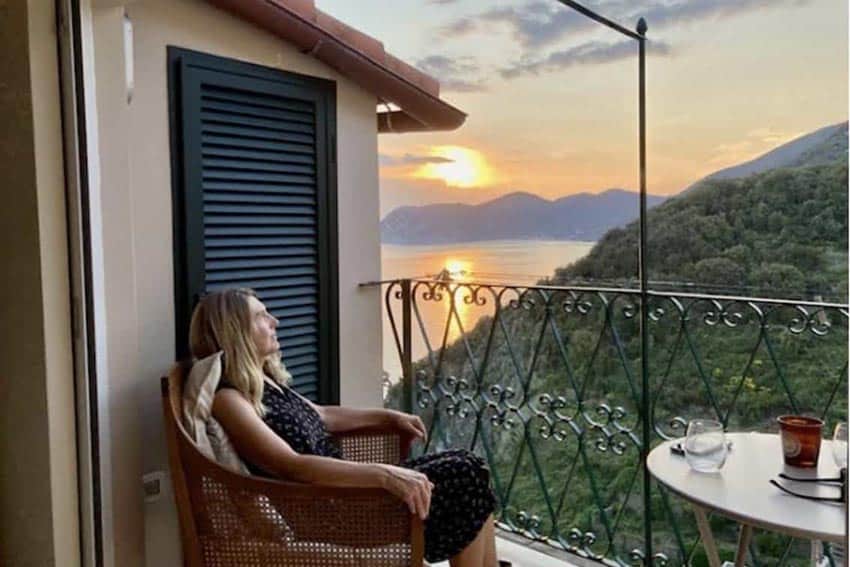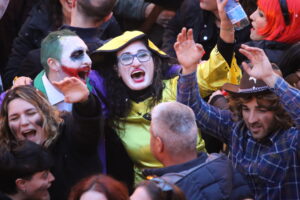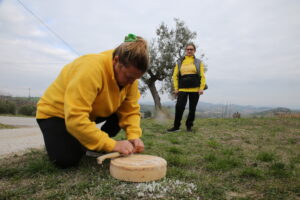
By Christopher Ludgate
Ask any local, and they would agree that Bologna is the true center and the very first major metropolis of Italy. It is the place where many ancient roads converged even in the ancient empire.

“During the Middle Ages, Bologna had almost 100 towers, and today they call it the medieval Manhattan. Now there are 33 remaining, some of them very visible, some of them hidden between buildings,” Bologna native Alice Brignani revealed.
The city’s hub, Via la’Independenza, is situated on the ancient Roman crossroad. Today, it is also where the Grand Hotel Majestic, a one-time seminary circa 1732, sits.
The landmark’s impeccable Classical Venetian-designed rooms – many dedicated to composers – each have unique fabrics and furnishings. From the lobby’s Murano chandelier to I Carracci restaurant, every detail is quintessential romantic Italia.
Upon our transportive tour of the hotel, Katarina and I stopped by a velvet rope in the basement with our guide, Laura.
“During a reconstruction project,” Laura motioned, “it became clear that we unearthed the ancient crossroad with the preserved etchings of the chariot wheels path.”
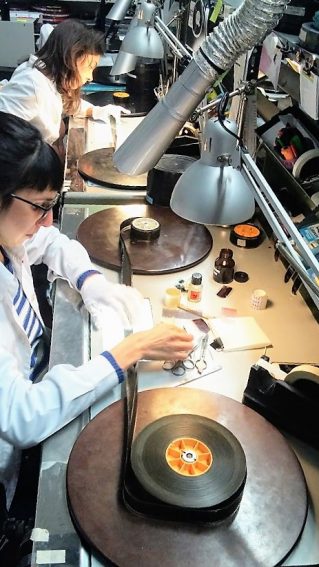
I couldn’t get over the juxtaposition of this Roman road from 1 or 2 B.C. exposed before us just on the other side of this velvet rope.
Continuing our trip back in time, we roamed, translating the city center’s street names which honor trades of old Bologna, having a chuckle at Via Malcontenti.
Cineteca di Bologna
The roads and restaurants were lively in the evening after a private tour of the archives and busy labs of Cineteca di Bologna where technicians were intensely focused on their admirable work preserving and restoring thousands of films deemed well-deserving of being preserved or even rediscovered in the name of being appreciated in both film and Italian culture.
The sight of endless shelves of canisters and reels along the walls spoke of this incredibly arduous task as we walked with restoration expert, Celene Pozzi.
Vinegar Smell of the Solutions
The vinegar smell of the solutions permeated through parts of the basement lab where rolls of film and sprockets streamed through a costly mechanical process. In dark studios, the high-tech boards were mastered by engineers doing the tedious, but satisfying work of resynching and fine-tuning important masterpieces to reintroduce to the world.
Cineteca is well-known to film professionals and serious film buffs worldwide offerings of training programs to students from around the globe and traveling exhibits. It is a big part of the pulse of Bologna with outdoor film festivals and programs like Il Cinema Ritrovato featuring live orchestral music held in the city’s famous piazzas.

“Restoration represents not only the best-possible tool for preserving filmic visions over time but also a way of re-launching them into a qualitative dialogue with contemporary audiences,” their mission states.
Still, a proud and progressive university town, Bologna celebrates sophisticated tastes in art, intellect, and food. It’s not a discotheque kind of town, but there are some rowdy pubs we encountered in the Irish district after a classic meal at Al Caminetto d’Oro making our way toward the historic opera house, Teatro Communale di Bologna, for a new grunge-era production of Puccini’s La Boheme.
Surprises in Maggiore
Katarina and I met Elena Bonesi from Bologna Welcome for a stroll through the pumping bustle toward Piazza Maggiore, Bologna’s most lively artery, which reflected juxtapositions of the contemporary and the well-preserved historic.

En route to Basilica San Petronio, we encountered a scene of admirers in the shadows of the newly restored Fountain of Neptune at Piazza Nettuno. He commanded attention with his grandeur.
Commissioned by Pope Pius IV and erected in the mid-16th century by sculptor, Giambologna, the nuances of the towering figure embody power and gravitas of the Roman God with that trident in hand. Neptune’s other hand is another story.
“Let’s walk over here and look for the darker stone and look at him. Tell me what you see,” Elena asked, leading us and revealing the well-known visual effect of what no longer appears to be his pointed finger, but his well-endowed erect member. Touché, Giambologna.
Once inside the medieval basilica, we followed the constellations along a meridian line that’s inlaid at a seemingly odd, but precise angle on the floor. Elena explained that this “tenth-largest church in the world was meant to be the largest initially, as Bologna was a progressive main hub of Italy. But the competition from Rome halted the basilica’s construction, and it was never finished.”
The relics of its namesake, Bishop Petronius, are interred within an exterior wall by a marker reading Felsinae Thesaurus.
Cassini’s Chair
Created by an astronomy professor of the prestigious University of Bologna, Giovanni Domenico Cassini, in 1655, the line indicates the days of the year and the length of a solar year rather than simply telling the time like the meridians of that era.
It was an incredible feat to have the advanced mathematical ability to be as precise as it is when the sun beams through the ceiling’s hole. What that science implied in the 17th century was not exactly embraced by flat-earth mentalities.
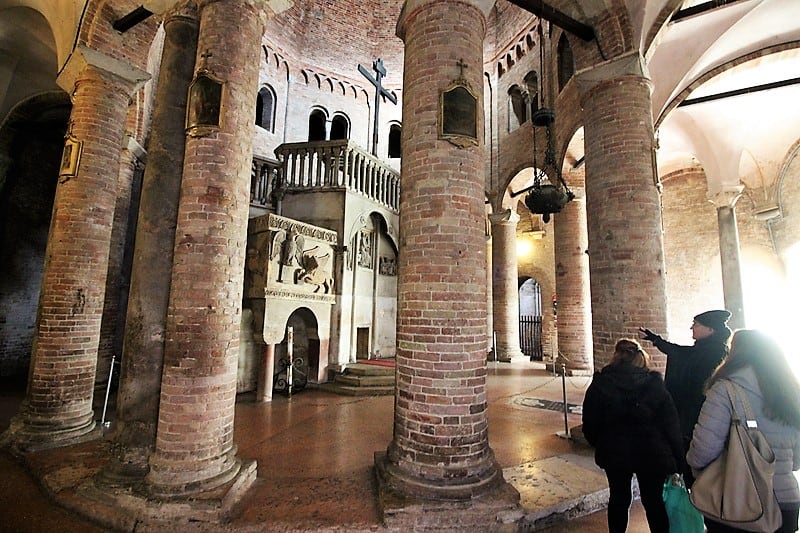
It’s small enough to overlook if one does not know, but it is Cassini’s chair perched up by the stained glass façade, left by the astronomer himself.
The 5th-century Basilica dominates the piazza. Entry to the church is about $3. Do not be surprised to see heavily armed guards there, for on the wall of an interior chapel hangs a 15th-century fresco painted by Giovanni da Modena that depicts The Judgment in Dante’s Divine Comedy.
While that is not unusual for a church, it is the only known Judgment to feature the Prophet Mohammed being cast into Hell with Lucifer, making the church a target of numerous terror threats and thwarted attempts.
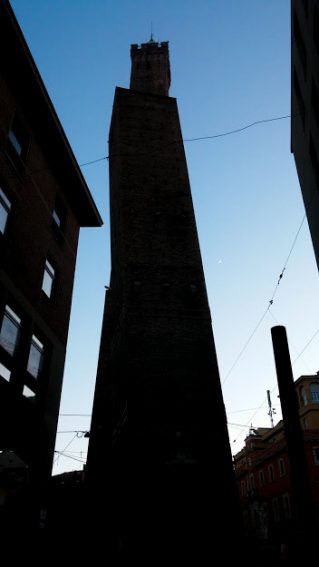
Two Towers and Seven Churches
Le Due Torri served as a lookout of a military base in 12th-century Bologna. Looming above modern shops today that are reminiscent of trade in historic Bologna’s Mercato di Mezzo, the Torre degli Asinelli stands – or leans – at approximately 318 feet beside its little sister tower, Garisenda.
Our guide, Elena, explained that the entry doors seem so high up, not because the ground sunk so much, but to thwart invaders from entering easily. In the 15th century, the edifice had a staircase of 498 steps installed within which tourists can climb for free with a Welcome Bologna PLUS Pass. Tours can also be arranged at Le Due Torri.
As dusk set in, the photo-ops bloomed with shadows as we circled the two towers, admiring the angles against the modern milieu.
The Seven Churches in Bologna
Also located in the historic district is Sette Chiese – the Seven Churches – also known as Santo Stefano Basilica; seven physically bonded religious edifices whose first dates to the 4th century and is said to have been built atop a pagan temple of which a single column still stands. We squeezed in an impromptu self-tour of this patchwork of history that many Bolognians refer to as mini Jerusalem.
Guideless but intrigued, I felt compelled to eavesdrop on a tour guide describing the medieval ritual of expectant women who came to pace the 5th-century octagonal temple of the seven churches 33 times before praying to a nearby fresco of the Madonna.
The mysteries seemed to whisper inaudibly as statues stared through me into the past. Millennia-old pillars stood above the tests of time, where relics of saints remained, and etchings on the walls were likened to scars.
“If walls could talk,” I thought, wandering through the complex of structures reflecting a mélange of architecture and archeological devotion.
- JAMNOLA and Sazerac House: Celebrate New Orleans - July 30, 2022
- New Orleans’ High-tech World War II Museum - July 23, 2022
- Montreal: Eclectic Arts and Culture - May 9, 2022


